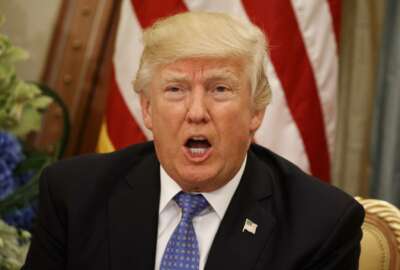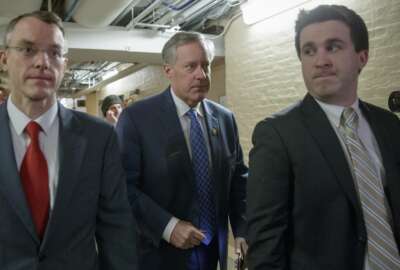
CBO weighs pros and cons of 5 possible changes to federal retirement
A new Congressional Budget Office study reviews a variety of possible options for the future of the federal retirement system.
The Congressional Budget Office reviewed a variety of different options for the federal retirement system, which may serve as an entree for lawmakers as they consider significant changes for federal retirees in the 2018 budget and beyond.
The report comes as both the Trump administration and Republican lawmakers have vowed to make changes to federal pay and benefits. Both the president and House Republicans in the past several months have offered their own ideas to cut federal retirement benefits as a way to realize new cost savings.
The latest CBO study on federal retirement benefits came at the request of the House Oversight and Government Reform Committee chairman. A spokesman for Rep. Trey Gowdy (R-S-C.) declined to comment on either the CBO report or the committee’s next steps on federal retirement.
“Lawmakers have expressed interest in examining the current structure of retirement benefits to ensure that the government provides adequate compensation to attract and retain skilled employees while not paying more than needed to accomplish that goal,” CBO wrote in the summary of its report.
CBO studied five potential changes to the federal system, and reviewed how much the government would spend or save in the short term and long term, and any potential impacts on recruitment and retention.
Three of the options suggested possible changes to federal employees’ existing pension plans, while the other two options would replace the pension plan with larger employee contributions to the Thrift Savings Plan.
Option 1
Increase employee contribution rates for current Federal Employee Retirement System (FERS) participants to 4.4 percent.
Currently, federal employees hired before 2013 contribute 0.8 percent toward their pensions. Employees hired in 2013 contribute 3.1 percent, while workers hired after 2013 contribute 4.4 percent. Future employees would also contribute 4.4 percent.
In the short term, Option 1 would save the government about $47 billion in cash between 2018 and 2027. Over 75 years, the government would spend about 3 percent less on pension and TSP contributions.
“Most of the revenue increases would occur in the years immediately following implementation, with a peak in 2021 (the last year of the phase-in period),” CBO said. “Revenue increases would build up and then gradually increase as employees hired before 2014 leave federal service.”
Federal retirees would see slightly lower retirement income with this option.
Option 1 would have little impact on agencies’ ability to recruit new talent, since the proposal only suggests changes for current employees, CBO said. However, it may affect government’s ability to retain top talent.
“The most experienced highly qualified employees would be the most likely to resign because of a rise in the employees’ contribution rate,” the report said. “That is in part because the most experienced employees have served long enough to be eligible for FERS pension immediately upon leaving the federal workforce and are forgoing pension payments by remaining in federal service.”
Option 2
Lower pension contributions for employees hired in 2013 or after. Have all employees contribute 0.8 percent to their pensions.
Agencies, therefore, in this case, would end up contributing more toward the pensions of employees hired after 2013.
In the short term, government would spend $32 billion on retirement costs between 2018-2027 for Option 2. Government’s net costs would rise by 13 percent over the next 75 years, compared to current law.
“Revenues would drop in 2018, the year of implementation, and continue to decline gradually,” CBO said. “As a result, net outflows would increase in 2018 and gradually increase over time. However, they would eventually decline as a share of GDP, as the size of the federal workforce declines as a share of the total U.S. workforce, CBO projects.”
Current pay would increase for federal employees hired in 2013. CBO says income for retirees would only increase modestly and may only occur as employees choose to stay in federal service longer.
Option 2 would help agencies better recruit and retain a talented workforce, CBO added. Lowering employee contribution rates would make the pension plan more appealing to workers who aren’t sure how long they plan to stay in federal service.
Option 3
Change the method for calculating the pension formula. Use an average of an employees’ highest five years of earnings rather than the current highest three years.
Government would spend $3 billion less on retirement costs over the next 10 years. Spending on TSP and pension contributions would fall 3 percent over the next 75 years, CBO predicts.
“Because Option 3 would affect only future pension recipients, the savings would increase gradually over time as more federal employees retired under the new rules, and then decline slightly as a share of GDP,” CBO wrote.
Because Option 3 would only impact employees’ future pension payments, it would have no effect on employees’ income or retirement contributions. CBO does, however, predict “modest reduction[s]” in retirees’ income.
Option 3 may make it slightly more difficult for agencies to recruit and retain top talent. But reducing pensions may cause less harm than some of the other options, CBO added.
“First, research indicates that past changes in retirement benefits have had less effect on recruitment and retention than past changes in salaries,” the report said. “Second, lower pension payments would make the mix between current pay and retirement income offered by the federal government more like that offered by private-sector employers.”
Option 4
Eliminate the pension plan. Increase the government’s automatic TSP contribution to 8 percent of an employee’s salary, with a 7 percent government match.
Option 5
Eliminate the pension plan. Increase the government’s automatic TSP contribution to 10 percent of an employee’s salary. Eliminate the employer’s match.
Both options 4 and 5 would only impact new employees, as current employees and their agencies are already contributing to their pensions.
Both would have similar impacts on government revenues and cost savings. Government would spend more on retirement under these options compared to current law during the first 10 years of implementation. Savings would come much further into the implementation than the other options, CBO said.
Both options would also impact agencies’ ability to recruit and retain qualified employees. Workers would bear more risk without a pension, but prospective employees may enjoy the flexibilities that a defined contribution plan might give them, CBO said.
“Many prospective employees who are uncertain how long they will stay in federal service might prefer the agency’s additional contributions over the pension because they could keep most of the agency’s contributions no matter when they left the federal workforce,” the report said.
According to an April study from CBO, government’s current defined benefit retirement package is the biggest contributor to the 17 percent compensation gap between federal employees and their counterparts in the private sector.
The report threw more fuel on the fire in an ongoing push for civil service reform and reemphasized past arguments that federal employees are simply paid too much. For others, it reinforced government’s struggles to recruit and retain top talent in mission critical areas.
The president’s 2018 budget request includes four specific changes to the current federal retirement system in an effort to realize more than $4.1 billion in 2018 and roughly $200 billion over the next 10 years.
The House Budget Committee’s 2018 request included similar recommendations but a more modest estimate for cost savings. The committee’s budget includes reconciliation instructions to the House Oversight and Government Reform Committee to find $32 billion in cost savings over the next 10 years through changes to federal retirement.
Copyright © 2025 Federal News Network. All rights reserved. This website is not intended for users located within the European Economic Area.
Nicole Ogrysko is a reporter for Federal News Network focusing on the federal workforce and federal pay and benefits.
Follow @nogryskoWFED
Related Stories

Trump’s proposed retirement changes would have major impacts on current feds and retirees

Republicans gearing up for major changes to federal pay and benefits




